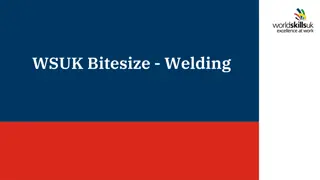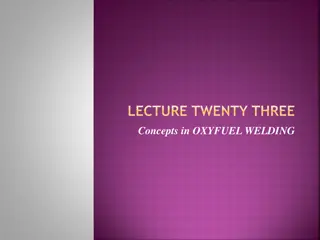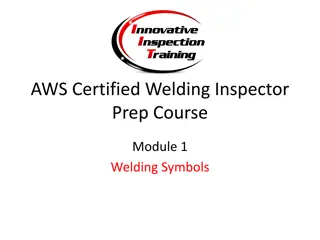Hot Work Safety Training for Welding and Cutting Operations
Bureau of Workers Compensation in PA provides training on health and safety for welding, brazing, and cutting operations. The training covers general requirements for fire prevention and protection, working on floors with openings, fire watch requirements, and precautions before welding. It emphasizes the importance of fire safety measures, fire watch responsibilities, obtaining permits, and prohibiting welding/cutting in unauthorized areas.
Download Presentation

Please find below an Image/Link to download the presentation.
The content on the website is provided AS IS for your information and personal use only. It may not be sold, licensed, or shared on other websites without obtaining consent from the author. Download presentation by click this link. If you encounter any issues during the download, it is possible that the publisher has removed the file from their server.
E N D
Presentation Transcript
Hot Work Bureau of Workers Compensation PA Training for Health & Safety (PATHS) Welding, Brazing, Cutting OSHA 29 CFR 1910.251-255 Subpart Q PPT-018-01 1
General Requirements Fire Prevention & Protection NFPA 51 B Standard for Fire Prevention in Use of Cutting and Welding Processes Move all fire hazards away from work area Use guards (fire blankets, etc.) if fire hazards cannot be moved PPT-018-01 2
General Requirements Working on floors with openings/cracks/grating: fire blankets to protect lower level from sparks and slag Have suitable fire extinguishing agents (extinguisher, water, sand, etc.) ready near cutting and welding operations PPT-018-01 3
Fire Watch Requirements A fire watch must be available where there is a fire potential or where . . . Combustible materials are closer than 35 feet to the point of operation Wall openings within the 35 foot radius exposing combustible material Material opposite metal walls and roofs could catch fire from conduction or radiation PPT-018-01 4
Fire Watch Requirements A person acting as a fire watch must have fire extinguishing agents readily available and be trained in their use A fire watch must be maintained for at least 30 minutes after work ceases PPT-018-01 5
Before Welding . . . Obtain a burn permit (hot work permit) authorized by the designated responsible person Sweep away all paper clippings, wood shaving, or textile fibers within a radius of 35 feet of cutting/welding operations PPT-018-01 6
Hot Work Permit PPT-018-01 7
Hot Work Permit Is a hot work permit required under related OSHA standards? NO! Is a hot work permit a best practice? YES! PPT-018-01 8
Welding/Cutting Prohibited in Areas not authorized by company management Areas near large quantities of readily ignitable materials such as baled paper or cotton Sprinklered buildings while sprinklers are impaired or out of order The presence of explosive atmospheres such as unclean or improperly prepared tanks PPT-018-01 9
Management Responsibilities Recognize safe usage of welding/cutting/burning equipment on its property Establish areas for cutting and welding operations Protect welding leads from damage by vehicles, slag, etc. PPT-018-01 10
Management Responsibilities Designate a responsible individual to authorize hot work permits Insist that cutters/welders are trained in safe work habits for their specific tasks Advise all contractors about flammable or hazardous materials PPT-018-01 11
Welding or Cutting Containers Ensure that used containers (drums, barrels, tanks) have been thoroughly cleaned of flammable materials including grease, tars, and acids All spaces must be vented and purged before welding Purging with inert gas is recommended PPT-018-01 12
Confined Spaces Keep all cylinders outside confined spaces Turn off gases at cylinders and purge lines when away from the confined space work area Remove electrodes (rods) from electrode holders (stingers) and disconnect machine power source PPT-018-01 13
Working at Heights Workers on platforms, scaffolds or open sided floors must be protected from falls with: - A guardrail system or lifeline - Safety harnesses with lanyards Welding cable and hoses must be kept clear of passageways, ladders, and stairways PPT-018-01 14
Eye Protection Requirements Welders and welders helpers must wear appropriate eye protection Lens of welding hoods, cutting goggles, and hand shields must: Be arranged to protect face, neck & ears from radiant energy Be made of tempered glass and free of bubbles Have lens shade readily identified on glass PPT-018-01 15
Radiation Hazards Results of excessive exposure to ultraviolet radiation Causes eyes to feel like they are full of sand Can lead to premature cataracts of the eyes Protect against ultraviolet radiation, sparks, fumes, and slag Wear protective clothing and respirators Provide warning signs to warn of hot metal Use ventilation or suitable respiratory protection PPT-018-01 16
Ventilation General - mechanical, 2000fpm 10,000 ft. 3 per welder ceiling less than 16 feet around structural barriers Local - mechanical, 100 linear fpm in weld zone When ventilation can not meet the needs supplied air respirators shall be used PPT-018-01 17
Ventilation Mostly require local exhaust ventilation or airline respirators (reference OSHA Standard): Fluorine Compounds Zinc Lead Beryllium Cadmium Mercury Stainless steel Chlorinated Hydrocarbons PPT-018-01 18
Acetylene Liquefied petroleum gas Formed when calcium carbide is submerged in water or in petrochemical processes Very unstable at pressures over 15 psi Never operate above 15 psi LEL = 2%, UEL=100% PPT-018-01 19
Acetylene . . . Does not require high storage pressure (the case with most LP gases) Is usually pressurized around 250 psi Turns to liquid over 300 psi Acetone liquid in cylinder lying horizontally takes at least 1 hour to settle to bottom when cylinder is set up vertically. PPT-018-01 20
Acetylene Gas Cylinders Gases in a typical acetylene cylinder Acetylene gas Acetone Porous filler Reserve volume 10 - 12 % 36% 42% 8 - 10 % Cylinders are filled with a porous material with millions of voids to help keep pressure from building up. PPT-018-01 21
Oxygen Cylinders Oxygen will not burn but will support combustion Oxygen is pressurized around 2,200 psi and the cylinder is hollow PPT-018-01 22
Oxygen Cylinders Keep oil and grease off oxygen cylinder valves and fittings (oil and grease will burn violently) Protect valves of oxygen cylinders (if valves are knocked off, the cylinder becomes a bomb ) Separate oxygen cylinders from fuel gas cylinders or combustible materials by a distance of at least 20 feet PPT-018-01 23
To Begin Welding or Cutting Oxygen = Acetylene = Threads-right-handed Threads-left handed hoses-green hoses-red Crack cylinders to blow out dirt or dust Open acetylene cylinders no more than 1-1/2 turns (3/4 turn recommended) Do not stand in front of regulator when turning it on -- the diaphragm in the regulator could blow outward PPT-018-01 24
To Begin Welding or Cutting Light acetylene first Open acetylene valve Adjust to no more than 15psi (5 to 7psi is common, depending on size of metal to be cut) Then turn on oxygen Adjust valve at torch head to fine tune flame to where blue flame is about 1/4 inch NOTE: Each fuel-gas cylinder lead should have a back-flow check valve & flash-back arrestor PPT-018-01 25
Stop Welding or Cutting Shut oxygen valve off first, then acetylene Oxygen cylinder valves should be opened entirely Turn main valve off and bleed lines Mark empty cylinders MT or Empty with railroad chalk When moving cylinders, roll them on their bottom edges PPT-018-01 26
Special Precautions Welding fumes from zinc, cadmium, beryllium, lead, mercury, and stainless steel are addressed in OSHA standards Argon gas used in MIG welding operations must be handled as an inert gas and stored accordingly PPT-018-01 27
Safe Handling of Gas Cylinders When transporting cylinders, secure vertically and with gauges unattached Do not pry frozen cylinders - use warm water because of the fuse plug on the cylinder bottom Do not use valve caps to lift cylinders Improper & unsafe storage PPT-018-01 28
Safe Torch Handling Clean torch tips with tip cleaners, wires, etc. Do not re-light torch tip with hot metal PPT-018-01 29
Review Review your own safety policies regarding acetylene use. Only do hot work in designated/authorized areas. Ensure permit is in place and all parties aware. Ensure fire protection equipment is readily available. Ensure fire watch is posted for at least 30 minutes after work is done. PPT-018-01 30
Review If welding above openings/gratings ensure guarding is in place. Ensure welding gases and equipment are stored properly and safely. Ensure compressed gas cylinders are handled correctly. PPT-018-01 31
Contact Information Health & Safety Training Specialists 1171 South Cameron Street, Room 324 Harrisburg, PA 17104-2501 (717) 772-1635 RA-LI-BWC-PATHS@pa.gov Like us on Facebook! - https://www.facebook.com/BWCPATHS PPT-018-01 32
Questions PPT-018-01 33
Bibliography 29 CFR 1910.102 and 1910.153 Handbook of Compressed Gases, Compressed Gas Association, 14501 George Carter Way, Chantilly, VA 20151, latest edition. Air Monitoring for Toxic Exposures, Shirley A. Ness, Van Nostrand Reinhold. 115 Fifth Avenue, New York, New York, 10003, 1991. PPT-018-01 34























